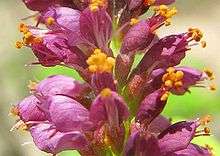Amorpha fruticosa
| Amorpha fruticosa | |
|---|---|
| | |
| Scientific classification | |
| Kingdom: | Plantae |
| (unranked): | Angiosperms |
| (unranked): | Eudicots |
| (unranked): | Rosids |
| Order: | Fabales |
| Family: | Fabaceae |
| Subfamily: | Faboideae |
| Genus: | Amorpha |
| Species: | A. fruticosa |
| Binomial name | |
| Amorpha fruticosa L. | |
| Synonyms | |
|
Amorpha angustifolia F.E.Boynton | |
Amorpha fruticosa is a species of flowering plant in the legume family (Fabaceae) known by several common names, including desert false indigo, false indigo-bush, and bastard indigobush. It is found wild in most of the contiguous United States, southeastern Canada, and northern Mexico, but it is probably naturalized in the northeastern and northwestern portion of its current range. The species is also present as an introduced species in Europe,[1] Asia, and other continents. It is often cultivated as an ornamental plant, and some wild populations may be descended from garden escapes.

A. fruticosa grows as a glandular, thornless shrub which can reach 5 or 6 meters in height and spread to twice that in width. It is somewhat variable in morphology. The leaves are made up of many hairy, oval-shaped, spine-tipped leaflets. The inflorescence is a spike-shaped raceme of many flowers, each with a single purple petal and ten protruding stamens with yellow anthers. The fruit is a legume pod containing one or two seeds.
6'-O-β-D-glucopyranosyl-12a-hydroxydalpanol, a rotenoid, can be found in the fruits of A. fruticosa.[2] Several members of the amorfrutin class of compounds have been isolated from the fruits.[3]
Cultivars
- 'Albiflora', with white flowers.
- 'Crispa', with curled leaves.
- 'Lewisii', with narrow leaves.
- 'Pendula', with arching branches, forming a dome shape.
References
- ↑ DAISIE (2009). Handbook of Alien Species in Europe. Dordrecht: Springer. p. 399. ISBN 978-1-4020-8279-5.
- ↑ Effect of new rotenoid glycoside from the fruits of Amorpha fruticosa LINNE on the growth of human immune cells. Hak Ju Lee, Ha Young Kang, Cheol Hee Kim, Hyo Sung Kim, Min Chul Kwon, Sang Moo Kim, Il Shik Shin and Hyeon Yong Lee, Cytotechnology, Volume 52, Number 3, 219-226, doi:10.1007/s10616-006-9040-5
- ↑ Weidner, C.; De Groot, J. C.; Prasad, A.; Freiwald, A.; Quedenau, C.; Kliem, M.; Witzke, A.; Kodelja, V.; Han, C.-T.; Giegold, S.; Baumann, M.; Klebl, B.; Siems, K.; Muller-Kuhrt, L.; Schurmann, A.; Schuler, R.; Pfeiffer, A. F. H.; Schroeder, F. C.; Bussow, K.; Sauer, S. (2012). "Amorfrutins are potent antidiabetic dietary natural products". Proceedings of the National Academy of Sciences. 109 (19): 7257. Bibcode:2012PNAS..109.7257W. doi:10.1073/pnas.1116971109.
External links
 Media related to Amorpha fruticosa at Wikimedia Commons
Media related to Amorpha fruticosa at Wikimedia Commons- Jepson Manual Treatment
- USDA Plants Profile
- GRIN Species Profile
- Amorpha fruticosa L. Medicinal Plant Images Database (School of Chinese Medicine, Hong Kong Baptist University) (traditional Chinese) (English)